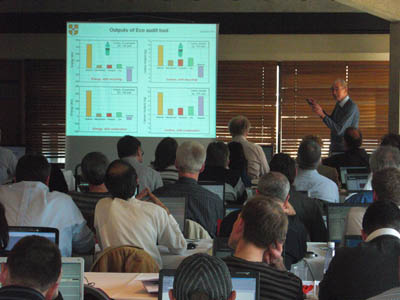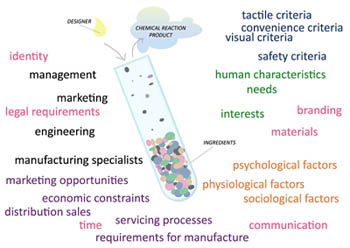Archive - 1st Symposium, 2009
International audience shares teaching ideas at CES EduPack Symposium
CES EduPack is being used to support and enhance teaching of materials and processes across an extraordinarily wide range of courses—and sharing experiences from across this spectrum is a very valuable exercise. That was a key lesson from the first international CES EduPack Symposium and Courses at Cambridge University, which brought together over eighty materials educators from 21 countries. Here we provide a brief summary of the event, including summaries of the key presentations and discussions.
Contents of this report
Professor Mike Ashby (Keynote)
Dr Claire Davis, University of Birmingham
(Large classes, enquiry-based learning, varied disciplines)Dr Frederic Veer, Technical University of Delft
(Use in architectural engineering)Dr Eddie Norman, University of Loughborough
(Use in teaching and project work for product design)Dr Hugh Shercliff, University of Cambridge
(Processing, mechanical engineering, materials fundamentals)Professor Yves Brechet, Grenoble Institute of Technology
(Problem-based learning, industrial case studies)
The CES EduPack Courses
The event began with two days of hands-on courses, which were fully subscribed well in advance of the event (apologies to those that we couldn't fit in this year!). Around forty academics attended an Introductory Course with Professor Mike Ashby. A further twenty joined them for the second day's Advanced Course, which looked at the EduPack resources in more detail and discussed their use in specific areas including eco design, materials and process selection, and research.
Professor Mike Ashby lecturing at the Advanced Course
Feedback from the participants was very positive, with comments including praise for the "open and friendly atmosphere" and "the quality of the presentations and materials". The hands-on, Q&A, and social sessions also allowed for exchange of ideas between participants and for Granta's attendees to gather feedback and suggestions for improvements and enhancements to CES EduPack.
Main Symposium
More attendees joined for the main Symposium session on Friday, April 1. Held in the University's Judge Business School, this consisted of six presentations from leading universities, discussion sessions, a poster session, and ample opportunities for networking.
Keynote presentation—Professor Mike Ashby, University of Cambridge
Mike Ashby opened the seminar by emphasizing the importance of teaching materials in the 21st century, with their critical impacts not just on product performance, but on the economy, safety, and the environment. He emphasized the range of students that need to learn about materials and processes. The need is obvious for students of materials science and related physical sciences. But these form a small proportion of a much wider group that includes mechanical, civil, chemical, general, biomedical, and aerospace engineers, architects, and industrial designers. This becomes evident as students move into industry—most companies need their materials experts, but these support a larger group of engineers and designers that require some level of materials knowledge. The ratio of materials experts to designers can vary from 5 or 10:1 in motor sports or aerospace to 400:1 in manufacturers of consumer products.
The engineering education community must respond to this varied and extensive need with teaching resources and approaches that provide the right level of materials knowledge to each student, while developing a common, consistent, core of shared knowledge across all disciplines. This philosophy has driven the development of CES EduPack as a campus resource in many universities. Different levels and features of the software and supporting resources are used at many points in the curriculum, helping to teach specific topics, but also offering some consistency and creating a link between these areas for the student.
Mike Ashby discussed different models for the teaching of materials. Most courses include a blend of methods. So EduPack aims to provide flexible resources that help teaching, regardless of the approach. |
Professor Ashby discussed one model used to describe teaching approaches, in which traditional 'science led' courses, often regarded as more appropriate for scientists, are contrasted with 'design led' courses, which often resonate with designers or engineers. He remarked that either may be relevant, depending on the audience. Indeed, teaching often calls for a blend of the two. He also noted the many different methods applied in today's teaching—traditional lectures, texts, lab work, and exercises; self-taught units; remote learning; project-based teaching; and computer-based tools. The goal of CES EduPack is to provide support for the full range of approaches and methods—and Professor Ashby noted that the rest of the day's speakers illustrated this.
He then described the use of CES EduPack in the Engineering Course at Cambridge—from a first year introduction to materials, to third and fourth year teaching in areas such as processing and sustainable manufacturing. Key points were the need to integrate use of EduPack resources into teaching programs and the value of short web-based 'nuggets' (exercises, text, and video demonstrations) in supporting students' use of the software.
Finally, Professor Ashby reviewed recent enhancements to CES EduPack, such as information on durability and the Eco Audit Tool, and invited input from the audience on developments that would help their teaching.
Dr Claire Davis, University of Birmingham
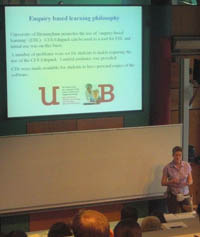 The second speaker was Dr Claire Davis, discussing 'Independent learning using CES EduPack with large class sizes'. Dr Davis first described the background to materials teaching at Birmingham. The University created a new School of Engineering in 2003, combining smaller departments, with a common first year course including a module "Properties and Applications of Materials". This is taught to students in areas ranging from biomedical and chemical engineering, through mechanical engineering, to sports and materials science. The course has to support students with a great variety of backgrounds through large lecture classes and hands-on laboratory classes.
The second speaker was Dr Claire Davis, discussing 'Independent learning using CES EduPack with large class sizes'. Dr Davis first described the background to materials teaching at Birmingham. The University created a new School of Engineering in 2003, combining smaller departments, with a common first year course including a module "Properties and Applications of Materials". This is taught to students in areas ranging from biomedical and chemical engineering, through mechanical engineering, to sports and materials science. The course has to support students with a great variety of backgrounds through large lecture classes and hands-on laboratory classes.
CES EduPack had been used for many years within the Materials Engineering department for small classes including formal teaching within computer sessions—how could it support the new course? The University of Birmingham promotes the use of 'enquiry-based learning' (EBL) and so the course incorporated a number of problems for students to tackle that required the use of the CES Edupack, with limited guidance. CDs were made available for students to have personal copies of the software. In questionnaire feedback, 74% of the students chose to use the software and 94% recognized its potential as an effective learning tool. One barrier to use was unfamiliarity with the software—some students expressed a desire for support classes. Another was the initial incentive to use the software—some students even requested that use be made compulsory.
Dr Davis and her colleagues did not want to introduce assessed tutorials or schedule computer sessions due to the cost in time, to scheduling challenges, and because they would not promote independent learning or EBL. However, the teaching team did develop a workbook as a substitute to lectures. Lecture sessions were then used to discuss the worksheets. The workbook included short exercises searching for materials data, short problem-based case studies, longer case studies similar to those available in the CES EduPack resources, and ‘bite size’ guides to tasks using the software. Positive results have included more comments on the ease-of-use of the software, first year students using the software in other modules when not required to do so, and second year students requesting personal copies.
In conclusion, CES EduPack was successfully introduced within large-class first year teaching across Engineering—a success enhanced with development of additional resources based on an analysis of how students actually use the software. This work is discussed in: S. Abdul-Rehman, C. Davis, ‘Independent learning using the CES EduPack software with large class sizes’, accepted for Journal of the Higher Education Academy Engineering Subject Centre, Volume 4 Issue 1, 2009.
Dr Frederic Veer, Technical University of Delft
Dr Frederic Veer spoke about the development of a materials science component within the Architectural Engineering curriculum at Delft.
Engineering design always deals with translating a theoretical concept to a material one, argued Dr Veer. Thus materials science must be a core supporting discipline for design and architecture. But courses in these areas are typically governed by a particular problem solving method and a particular approach to design problems (for example, a 'shape-first' approach in architecture). Coordinating teaching so that knowledge developed in the supporting module links effectively to the core subject can be difficult. Conventional teaching methods—for example, prescribing a book and then explaining materials science via lectures supported with lab work—are not a good solution. And they are often not a good fit to today's students, who use laptops for everything from information gathering to social networking and entertainment.
Dr Veer's hypothesis was that a more effective way to teach materials science as a supporting discipline is as follows:
- Use a laptop-based materials selection tool (he uses CES EduPack)
- Teach how to use the tool in the design setting
- Then introduce the supporting theory and reinforce with lab work
- Coordinate with design teachers so that the materials and core courses link
Based on this hypothesis, he has evolved a course over several years based on these elements:
- Lectures based on the book "Materials: Engineering, Science, Processing, and Design" (Ashby, Shercliff, and Cebon) with CES EduPack used interactively to illustrate theory—for example, the comparative contribution to strengthening in Al-Mg alloys of cold work and solution strengthening (shown below)
- CES EduPack exercises that relate to architectural engineering, written with design teachers—an example is making the students consider whether it is possible to design a clear plastic box that can be joined with similar units to make a tunnel of specific dimensions
- Lab work conducted halfway through the semester—the main goal is to show the statistical nature of materials strength and thus the importance of understanding the limitations of materials data
- A workshop on designing with innovative materials using CES EduPack
Results so far indicate that students like the new approach. Materials science is being taken into account earlier and more effectively in the core design course—the two courses are now 'in phase'. CES EduPack is proving to be a tool that can be given to students with minimum introduction and which can be used both for practical design exercises and to introduce theory.
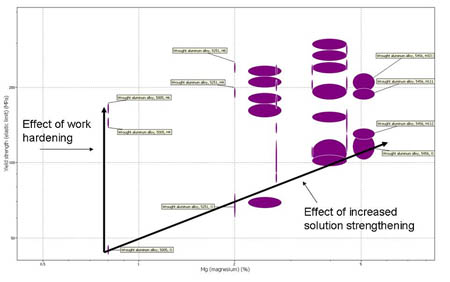
Using CES EduPack to illustrate theory
Dr Eddie Norman, University of Lougborough
Dr Eddie Norman of the University of Loughborough discussed finding a place for CES EduPack within product design education. His challenge is teaching materials in an environment in which the topic is just one of a range of factors that designers must consider (as illustrated below). Design does not lend itself to teaching in a linear fashion and requirements for supporting knowledge and skills are essentially task-related, rather than determined in a disciplinary sense. This means it is important to introduce materials science in an appropriate context, and that project work in which the students learn about materials while developing a design is particularly important.
One designer's view of the design process—materials is one element and 'any linear model of the process of design would be inappropriate' |
CES EduPack is first used in the context of planning for prototyping within a module of the Industrial Design & Technology first year course that is common to all courses. It is introduced into second year materials coursework through 'Getting Started with CES' exercises and coursework assignments (e.g., exercises on materials selection for a mobile phone housing or scissors). It is also used in a Sustainable Design option. Third year students are offered reminders on materials and process selection and new lectures on costing.
But perhaps the most interesting use of CES EduPack is to support materials analysis and selection in finalists' design projects. Dr Norman provided a number of examples where EduPack had been applied. These included choosing materials for an automatic door, designing a toy for music therapy, designing fitness equipment, and finding a more environmentally sustainable replacement for water bottles. Students used EduPack to analyze factors such as as weight, friction properties, wear resistance, hardness, corrision resistance, yield strength, flexibility, fatigue strength, and cost—as well as aesthetics.
The visual nature of EduPack, with its product pictures and descriptions at Level 1 and 2 and the clarity of materials property charts, when combined with its quantitative analysis of performance against design constraints and objectives, make it ideal for supporting such project work.
Dr Hugh Shercliff, University of Cambridge
Dr Hugh Shercliff of the University of Cambridge showed how the property charts in CES EduPack, originally developed to aid materials selection, can be used to teach engineers about materials processing and its use in the control of properties.
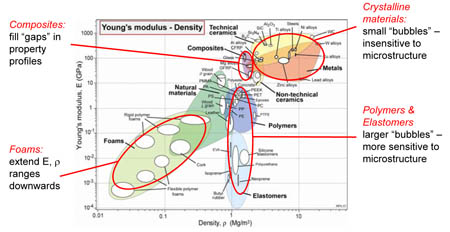
His starting point is a simple chart such as that shown, above, which plots Young’s Modulus against density for the full range of materials types. This enables discussion of the factors controlling these properties. How is this different for different families of materials? Why are these properties relatively tightly prescribed for crystalline materials and polymers? The answer, of course, lies in the atomic-level packing and bonding, which dictate these properties and leave comparatively little scope for manipulation of properties. Conversely, the teacher could discuss how the cell architecture of foams can be varied, leading to their relatively wide ranges and an extension of the property space covered. Similar plots could be used to discuss how the composition or geometry of composite materials can be altered to shift properties between the upper and lower bounds defined by the properties of the matrix and reinforcement.
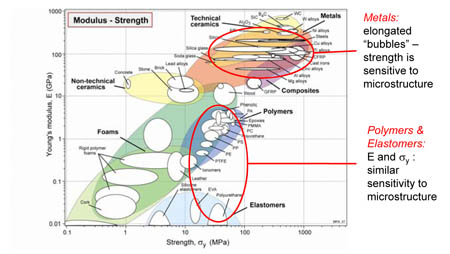
The majority of Dr Shercliff’s talk focused on the particularly important example of manipulating metal properties. The plot of modulus v strength, above, immediately shows how metals exhibit a very much wider range in strength than they do in modulus. Dr Shercliff showed how he uses property charts to explore with students the core concept of
Composition + Processing results in Microstructure + Properties
Hardening mechanisms such as solid solution, precipitation, and work hardening can be examined by explaining their effects on microstructure, and then relating those microstructures to points on the chart. The discussion can be quickly extended to properties other than strength, for example, fracture toughness. The figure below shows one example slide, in which microstructures resulting from different heat treatments of steels are related to the properties of the materials they represent.
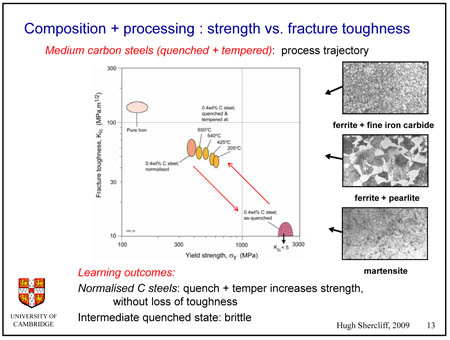
Dr Shercliff showed how such processing mechanisms can be explored one-by-one and then brought together, for example, by plotting a property chart for the full range of ferrous alloys to show how these fill an area of property space—and thus how property manipulation extracts a remarkable range of performance from these materials. He finished by giving a number of further examples of this teaching approach – for electrical properties and for polymeric materials.
In summary, Dr Shercliff showed how property charts are an effective graphical means to illustrate “processing and composition trajectories” and how CES EduPack works not just as a stand-alone selection system, but as a resource to create graphics and information that can be integrated into broader lectures and student exercises.
Professor Yves Brechet, Grenoble Institute of Technology
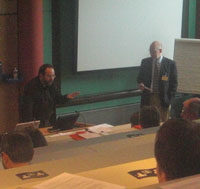 Professor Yves Brechet of the Grenoble Institute of Technology was the final speaker, discussing his use of CES EduPack in teaching materials engineering, particularly in case study-based learning.
Professor Yves Brechet of the Grenoble Institute of Technology was the final speaker, discussing his use of CES EduPack in teaching materials engineering, particularly in case study-based learning.
His course on Selection and Design consists of 8 lectures on materials, their properties, and selection, supported by tutorials using the CES software. Students are then challenged, in groups of 3 or 4, to work on real industrial case studies provided by industrial partners. They work on these projects over a 10 week period, with 2 half days per week scheduled for this work. At the end of this period they produce a report and must defend its contents publicly. Since he has been running this program more than 200 problems have been tackled. Recent examples include:
- Materials for electrical contacts (LETI)
- Heat exchangers (ALCAN)
- Finding applications for FeTiB2 (ARCELORMITTAL)
- Materials issues in heat exchangers for GenIV nuclear power (EDF)
- Finding applications for bamboo
- Materials for thermal inertia (EDF-CSTB)
- Thermostats ( Dauphinoise-Thomson)
Professor Brechet finds the CES software valuable in addressing these real life case studies. He estimates that in 50% of cases it is well-suited to solving the problem, in 25% of cases it offers some insight, and in 25% of cases new developments would be needed for the software to fully address the problem and the students must find an alternative approach.
Professor Brechet concluded by providing two interesting examples of further courses in which EduPack had been used. The first is in teaching nuclear engineering, where he showed how EduPack is used to demonstrate the suitability of zirconium alloys as a fuel cladding. The second—and certainly the most distinctive example of the day—was its use in a course on political science and technology! This unusual program brings together students of engineering and politics and includes materials lectures that look at how materials decisions impact society—for example, through their economic or environmental impacts. CES EduPack is used in project topics that encourage students to address these problems on a rational, informed basis.
In summary, Professor Brechet's experience over 15 years is that students like the case study based approach and CES EduPack—registration for this elective course has increased year-on-year and many former students in industry now provide the case studies for current students.
Symposium conclusions
As well as concluding that CES EduPack can support many topics, teaching approaches, and methods, a number of common themes emerged from the presentations:
- EduPack offers a good way to engage today's students, who increasingly expect to get information, learn, and work via a computer—the evidence is that students like it.
- It is important to integrate use of EduPack well into your course—this can be done for either an existing course or through design of a new course. In doing this, EduPack offers much more than a stand-alone selection tool—examples include its use in creating supporting graphics, as an information resource, and as a source of lecture slides, exercises, and projects.
- It is vital to consider how students work and how they will use the software as you design or adapt your course and in provision of supporting resources. This may vary by discipline and level—but breaking exercises and supporting resources into 'bite-sized chunks' seems to work particularly well in many cases.
During the discussions a wide range of suggestions for improving EduPack were gathered—these will be fed into planning for the CES EduPack 2010 and 2011 releases. The great work that many users have done in creating their own supporting resources was noted. Symposium attendees were keen to see this work shared online. A new area in the teaching resources site has since been created for such community resource sharing.
Social Program
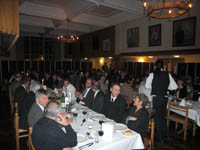 The Symposium was not all hard work! We benefitted from great spring weather, enabling visitors to sightsee, with the historic city of Cambridge at its best. The social program was centered on St Catharine's College, in the heart of the University, where most of the delegates also stayed. A well-attended Symposium dinner on Thursday evening (pictured) provided an attractive and relaxing setting for delegates to get to know one another better.
The Symposium was not all hard work! We benefitted from great spring weather, enabling visitors to sightsee, with the historic city of Cambridge at its best. The social program was centered on St Catharine's College, in the heart of the University, where most of the delegates also stayed. A well-attended Symposium dinner on Thursday evening (pictured) provided an attractive and relaxing setting for delegates to get to know one another better.
Based on the feedback from the first event, we are very likely to hold future Symposia—and we look forward to welcoming you to them. Contact us for information.

